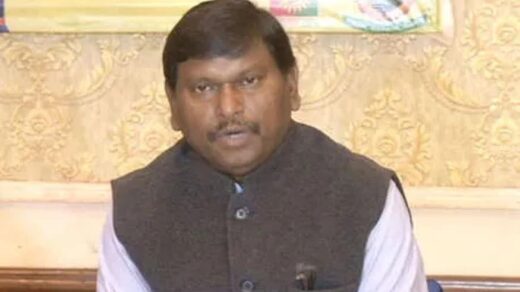Vice President calls for faster and more inclusive growth;
Asks universities to align research goals to solve challenges being faced by the nation;
Knowledge will soon be driver of Indian Economy and will play a vital role in improving the living conditions of the people: Vice President
India must reorient its higher education system to be globally competitive;
Our system of education and skill-training needs to respond to the demands of industry and services sector;
We must bring rural areas at par with urban areas in terms of ease of living and working;
Asks students to shun negativism, develop a positive attitude and be socially conscious, peace loving and empathetic;
Addresses 16th Convocation of Indira Gandhi Institute of Development Research
The Vice President of India, Shri M. Venkaiah Naidu has called for a faster and more inclusive growth. He said that knowledge is going to be the driver of the growth of Indian Economy and will play a vital role in improving the living conditions of the people. He called upon Indian Universities to rise to the occasion and reorient its higher education system to be globally competitive and to realign their research goals to meet real challenges that India faces.
He was addressing the 16th Convocation of the Indira Gandhi Institute of Development Research, established by the Reserve Bank of India, in Mumbai today. He applauded the Institute for having established itself as one of the excellent centers of higher learning and as an influential center of discourse on national and global development concerns. The Vice President gave away degrees to 43 graduating students and presented one gold medal for excellence.
On the occasion, the Vice President spoke about growth and development and highlighted the rapid economic progress and fiscal consolidation that India had undergone. Shri Naidu said that an emerging economy like India would constantly bring in new laws and regulations at par with international best practices. He observed that tax reforms were slowly increasing India’s tax base and shifting the social norms from one where it was alright to avoid taxes to one where the majority is willing to pay.
The Vice President opined that India’s demographic dividend was an opportunity and a challenge. He said that finding jobs for 12 million young people entering the labor force each year and millions transferring out of low productivity agricultural jobs is a major and continuing task.
Shri Naidu stressed that education is not only for employment, but also to empower the individual with knowledge and wisdom to sift the wheat from the chaff. ‘Access to quality education for all and at all levels is equally essential to ensure inclusive growth and prevent any kind of discrimination’, he added.
The Vice President emphasized that it was time for India to once again emerge as the global knowledge hub. He called upon the seats of learning, especially the universities, to reinvent themselves as hubs of vibrant intellectual pursuit with academic excellence and social relevance as the key touchstones of success. The Vice President also opined that our system of education and skill-training needs to respond to the demands of industry and services sector.
Touching upon agriculture and its importance in Indian economy, the Vice President said that we must not hesitate to introduce a number of structural changes in our agricultural sector to make it profitable. He highlighted initiatives like National Agricultural Market or e-Nam and spoke of the need to diversify crops further and increase the coverage of crop insurance.
Shri Naidu spoke of the need to augment our social infrastructure such as primary education, health care etc. Referring to Former President Dr. A.P.J. Abdul Kalam’s dream of providing urban amenities in rural areas, he said that we have to aspire to provide amenities like drinking water, street lights, education, healthcare and telecom services to the country’s rural areas, bringing them at par with urban areas in terms of ease of living and working.
The Vice President said that India has to reach out to other countries to access cost-effective technology, investment, and energy to manage its domestic challenges. He called for appropriate economic and foreign policies to navigate through this emerging and uncertain landscape.
Shri Naidu urged scientists, technologists and engineers to keep abreast of the developments and absorb new technologies as they occur. He reasoned that this absorption is necessary for our progress in a fast integrating world. ‘We must identify areas and spheres where we have comparative advantage and push ahead’, he emphasized.
He urged the graduating students to learn to preserve the best of traditional values, shun negativism, develop a positive attitude and be socially conscious, peace loving and empathetic. ‘Develop a constructive attitude and focus more on achieving perfection in whatever you do’, he said.
The Director of Indira Gandhi Institute of Development Research, Dr. S. Mahendra Dev, the Dean, Dr. Jayati Sarkar and others dignitaries were present on the occasion.
Following is the text of Vice President’s address:
“I deem it a matter of great privilege to be invited to address the 16th Convocation of the Indira Gandhi Institute of Development Research. Over its life of over three decades, the Institute has established itself as one of the excellent centres of higher learning. The Institute has emerged as an influential centre of discourse on national and global development concerns. Under the able leadership of its present Director Professor Mahendra Dev, the Institute has not only continued to build further on its initial strength but has added more dimensions.
Addressing such a learned gathering as we have today, I would like dwell upon a few thoughts on some of the issues pertaining to Indian economy.
Accelerated economic growth has been a major factor bringing down Indian poverty ratios, which were above 50 % in the 1960s. In 2011, after a series of global shocks, India’s macro economy was fragile, with a depreciating rupee, widening current account deficit, and high food inflation. Policy actions since helped improve these fundamentals.
A path of fiscal consolidation and implicit flexible inflation forecast targeting was adopted in 2014. Be it in the overall macro-economic context or specifically in finance, an emerging economy like India is constantly bringing in new laws and regulations at par with international best practices.
Tax reform is slowly increasing India’s tax base and shifting the social norms from one where it was alright to avoid taxes to one where the majority is willing to pay. Incentives are also working in that direction.
Looking ahead, for India to be a USD ten trillion-dollar economy in 2030 its real rate of growth must be at least 7% per annum. If we can achieve this, we will shift firmly from the World Bank’s lower income group to the upper-middle income group, which starts at a per capita income of USD 3856.
India has to grow out of many bottlenecks including inadequate public services, congestion and pollution, issues in health and education, bottlenecks in land, labour and financial markets etc. An arduous path lies in front of us.
For us to move to this growth path, we need to focus on research, innovation, sincere implementation and constant monitoring by following reform path.
An economy in transition should be one which is innovating. New technologies that leverage youthful skills and reduce prices to target low income masses can give India a special advantage. Aadhar and GST give one of the world’s largest data base that can be used for various innovations including in fintech. Internet based businesses including retail will be a major source of innovations given India’s large consumer base. Shifting to renewable energy sources and environment friendly technologies will be another.
India’s demographic dividend is an opportunity and a challenge.
By 2020 its estimated average age of 29 will be among the lowest in the world.
But finding jobs for 12 million young people entering the labour force each year, and millions transferring out of low productivity agricultural jobs is a major and continuing task.
In order to achieve the demographic dividend, some of the challenges for the country include improving healthcare, improving education facilities, skill development, developing good quality and low-cost housing, investment in physical infrastructure and and promoting small and medium enterprises while bolstering larger enterprises with global reach.
Please remember that knowledge is going to be the driver of Indian Economy and will play a vital role in improving the living conditions of the people. Therefore, India must rise to the occasion and reorient its higher education system to be globally competitive.
The education system should be reoriented by moving away from the colonial mindset and teach history in an objective manner as it actually unfolded, the richness of ancient civilization, culture and heritage and instill the values of nationalism among the students.
Education is not only for employment. It should empower the individual with knowledge and wisdom to sift the wheat from the chaff. Access to quality education for all and at all levels is equally essential to ensure inclusive growth and prevent any kind of discrimination.
I would like to emphasize that the time has come for India to once again emerge as the global knowledge hub. For that to happen, the seats of learning, especially the universities, must reinvent themselves as hubs of vibrant intellectual pursuit with academic excellence and social relevance as the key touchstones of success.
India’s development trajectory thus far stands out among other countries in that the economy has transformed from being predominantly agricultural in 1947 to being services dominated, largely bypassing the phase of rapid industrialization that other high income countries witnessed during their own development.
While agriculture now accounts for less than a fifth of GDP, it still remains the main source of employment for nearly half the labour force.
For the unskilled workers migrating out of agriculture it is the low value services and not manufacturing that is the first port of call.
Share of manufacturing in total employment has remained fairly low at about 12 percent. This is in sharp contrast, not just with the developed countries, but even with Asian peers such as China and South Korea where it is higher at around 16 percent to 19 percent. The government’s “Make in India” initiative is driven by its desire for rapid structural change and growth.
An important feature of Indian agriculture is the presence of very large number of farmers (about 90 million farm households), and the very low average farm size – majority of farms are less than 1 hectare. These millions of farmers typically sell their produce in to wholesale markets. Consequently, farmers do not benefit from high prices at the retail end. This market structure is an important reason for the low labour productivity in the sector. To improve labour productivity in agriculture, we need (i) innovative institutional arrangements for some form of “collective” marketing by farmers (e.g., cooperatives, farmer producer organization, etc.) to improve their bargaining strength in the market; (ii) greater on-farm value addition / agro-processing (cleaning, cutting, packaging, etc.), (iii) development of agricultural marketing chains and agriculture specific infrastructure, and (iv) development of agro-processing industries.
Thus, we must not hesitate to introduce a number of structural changes in our agricultural sector to make it profitable.
Initiatives like National Agricultural Market or e-nam have helped in improving the profitability of agriculture by better access to markets and information.
We must also focus upon diversifying of crops further and increasing the coverage of crops under insurance.
Goal 8 and Goal 5 of the Sustainable Development Goals (SDGs) are directly relevant in the context of labour and employment. To recall, Goal 8 is “Promote sustained, inclusive and sustainable economic growth, full and productive employment and decent work for all”, while Goal 5 is “Achieve gender equality and empower all women and girls”. On both these aspects several issues confront the country.
How to facilitate job creation for people looking for jobs and that are entering the labor force? The annual addition to working age labor force (those falling in the age bracket 15-59) is estimated to be in the range of 5.8 million for the period 2015 to 2030. It is estimated that India will have to absorb around 16 million persons in new jobs over the next 15 years.
The future skill-profile of workers demanded by Industry and services sector could undergo dramatic change. Our system of education and skill-training needs to respond to the demands of industry and services sector. The pace of skill development would also be important if we have to benefit from the demographic transition.
We need to focus on skill upgradation and promote innovative entrepreneurship to meet the demands of various sectors, including agriculture.
We must also promote self employment, set up and empower more self help groups and promote village and cottage industries.
Large proportion of India’s labor force is engaged in informal work or work in informal enterprises. The challenge is two-fold. How to incentivize the entrepreneur to set up new enterprises in the formal/organised segment of the economy? How to encourage currently operating enterprises in the informal segment to move into the organised sector?
Gender disparity in labor market which has many dimensions needs to be addressed. The low share of women workers in organized sector and the lower wage per day of work for women in all types of wage employment are the striking features.
Developing countries need, among other things, an infrastructure push to sustain growth over the next generation. Infrastructure can be divided into three parts: trade and transport corridors, industrial zones, and social infrastructure.
Over the past decade, the importance of the West as the dominant source of international export demand has declined. Developing countries are confronted with the need to find newer markets within their boundaries and in other countries in the global south. This requires reorientation of westward trade channels through massive investment in intra-national (Bharatmala Project and Delhi-Mumbai Industrial Corridor), inter-national (India-Afghanistan air corridor, Kaladan Multimodal Transit Transport Project connecting India and Myanmar, and India-Bangladesh rail, road, and sea transport projects), intra-regional (BBIN /Bangladesh, Bhutan, India and Nepal projects), inter-regional (India-Iran-Afghanistan International Transport and Transit Corridor and India-Myanmar-Thailand trilateral highway), and inter-continental (International North-South Transport Corridor and Asia-Africa Growth Corridor) physical connectivity. This is the context for the growing interest in domestic and transnational infrastructure over the past decade.
As far as the Social Infrastructure is concerned, building primary education, health care, and waste management facilities across the country, development of new small towns and renovation of existing towns and connecting them with local labour intensive manufacturing and services industries, and decongestion of existing metropolitan cities would be of utmost importance.
We have to aspire to achieve Former President Dr.A.P.J. Abdul Kalam’s dream of providing urban amenities in rural areas, which he termed as “PURA”.
The social inclusion programme he envisioned aims at providing amenities like drinking water, street lights, education, healthcare and telecom services to the country’s rural areas, bringing them at par with urban areas in terms of ease of living and working.
What will the world look like in 2030? Where do we see ourselves in that world? How should we choose our objectives? How should we build capacity to pursue those objectives? The answers to these questions have to be located in our interlocked domestic and international contexts.
To manage its domestic challenges, India has to reach out to other countries to access cost-effective technology, investment, and energy. India needs appropriate economic and foreign policies to navigate through this emerging and uncertain landscape.
Our scientists, technologists and engineers must keep abreast of the developments and absorb new technologies as they occur. In a fast integrating world, this absorption is necessary for our progress.
We must identify areas and spheres where we have comparative advantage and push ahead.
Our development challenge can only be met by focusing on the expansion of the knowledge base. We must focus on improving the quality of research and fostering innovation. That alone will be the required game changer.
That is why we need institutions of excellence like Indira Gandhi Institute of Development Research. May I wish everyone of you success in your future endeavors.
My dear young friends who are being conferred with prestigious degrees today,
Convocation is a crucial ceremony in your life. It marks a significant transformation in your life.
Let me impress upon you that the nation looks up to you with great many expectations.
You must learn to preserve the best of traditional values, shun negativism, develop a positive attitude and be socially conscious, peace loving and empathetic. Develop a constructive attitude and focus more on achieving perfection in whatever you do.
You should learn to love nature and live with nature and care for the preservation of natural resources and environment to create a more sustainable planet.
As you strive to reach these goals, you will face a number of challenges your way. You will see as many setbacks as victories.
But I am confident that you will surge ahead, armed with knowledge and wisdom and the many great qualities that this great institution has nurtured in you.
I am confident that you will be the authors of New India’s growth story.
Let me congratulate you once again on this accomplishment.
I wish each and every one of you and the Indira Gandhi Institute of Development Research a very bright future.
Jai Hind!”
***











